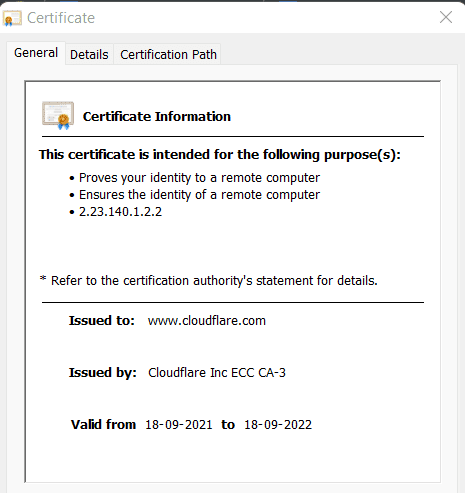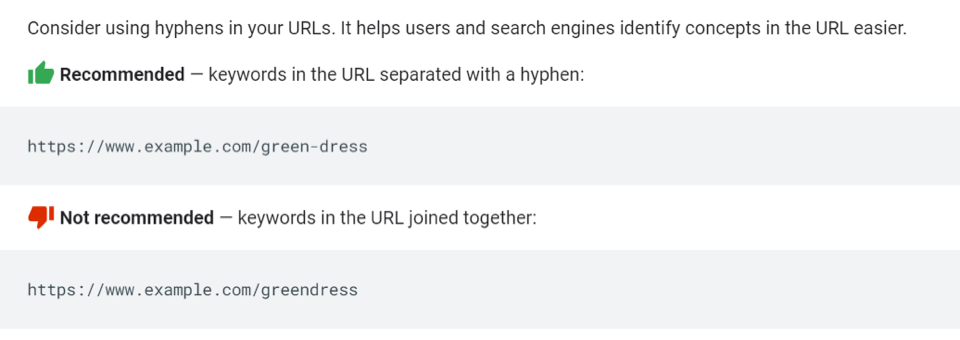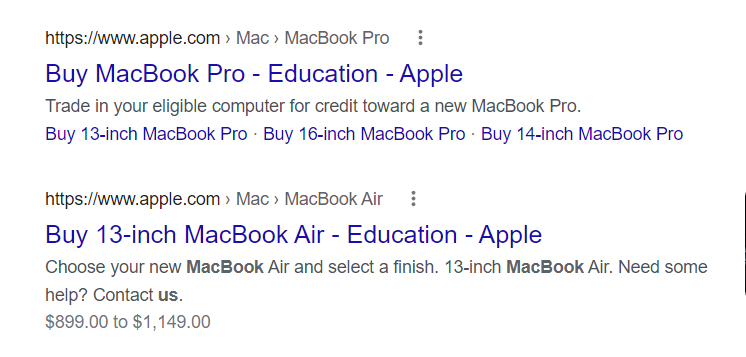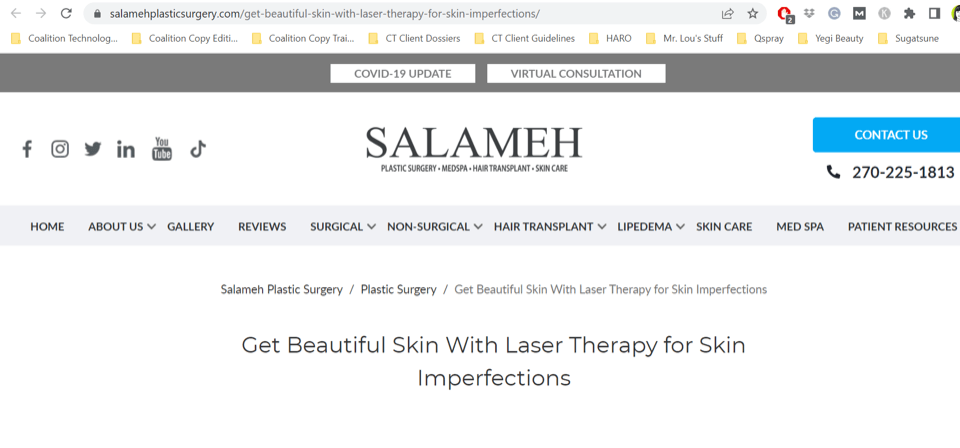Uniform Resource Locators, or URLs, might just be one of the most underutilized tools for SEO and UX optimization. URLs are so much more than just links that take your users from one page to the next. An SEO-friendly URL structure can help your page rank higher in searches and also improve the way visitors navigate your website.
Is Optimizing URLs For SEO Worth It?
So what’s the verdict? Should an SEO-friendly URL structure be a priority, or is it acceptable to leave your existing structure intact? We can look at Google’s Advanced SEO developer documentation for a definitive answer.

Google’s own documentation recommends an optimized URL structure for SEO, with keywords separated by hyphens and avoiding long strings of numbers. This is because crawlers find it far easier to index pages with simple structures.
Refining The User Experience
URLs are one of the first impressions that searchers have of your website, along with the meta description. An SEO-friendly URL structure will work with your meta description to create a holistic image of what your website offers your visitors.

Not only does this structure inform visitors about what they can expect to find on the page, but it also makes for a better overall navigation experience. A user experience study indicates that 69% of users will favor a brand that offers a consistent experience, both online and offline. As a marketer, you should remember that the URL is part of that experience.
Websites that have optimized URLs for each page reassure users that the website is reliable and regularly updated — which is also great for SEO. URLs that are misleading or confusing, such as those with long strings of numbers and parameters, will have the opposite effect. A savvy marketer won’t miss the opportunities presented by a URL to carve out a more pleasant user experience.
There’s been a lot of talk about SEO-friendly URL structures so far. Let’s have a look at what this ‘structure’ actually means, and what you should aim for in your own pages.
URL Structures
Let’s break down what a URL structure is with an example.
https://www.bestseoservicecompanies.com/category/page
The https:// is known as the protocol of the URL, while the www. is the subdomain. You might’ve noticed that browsers don’t bother to show or ask for the protocol when you’re entering an address, but they’re still a useful part of an SEO-friendly URL structure — we’ll discuss why later.
The actual name of your website, in this case bestseoservicecompanies, is the root of the URL. This is then followed up by .com, the top-level domain, or TLD. Finally, the category and page sections are called the slug and permalink respectively.
That said, it’s worth remembering that structures can vary significantly depending on the type of the website in question when you’re optimizing URLs for SEO. For example, a blog could follow the typical structure shown above, but an ecommerce store with multiple different product pages and sorting options might have much longer URLs with multiple parameters.
Speaking of which, let’s have a brief look at what a parameter is and why they’re important for you.

We’re using an ecommerce website here since they tend to use multiple parameters. In this example, the ptype= is what’s known as a parameter, and they’re easy to spot since they’re always preceded by a question mark. Keep these parameters in mind as we go through the process of creating an SEO-friendly URL structure in the next section.
Optimizing URLs For SEO
Keep in mind that your end goal should be to craft a better experience for the user rather than the search engine. If you optimize for the user, you’ll also end up optimizing for search engines. The role keywords play in URLs when it comes to search engine rankings should be a secondary consideration when you’re optimizing URLs for SEO.
Prioritizing Security
The path towards an SEO-friendly URL structure starts at the very beginning of the URL. Remember the protocol? The difference between https and http is massive, and it’s worth paying attention to if you’re a marketer. HTTPS indicates that the website has been secured against certain attacks with encryption, whereas HTTP websites are unencrypted and vulnerable to loss of data.
Securing your website with SSL encryption gives you an SSL certificate and access to the HTTPS protocol. Searchers will also be able to see that your website’s been secured against attacks and will naturally feel more comfortable clicking through. They can view and verify that certificate if needed.

Interestingly, around 25% of websites still haven’t transitioned over to the HTTPS protocol. This means that optimizing for security can give you a competitive advantage over other URLs in the race for SEO.
URL Writing Best Practices
The golden rule of creating an SEO-friendly URL structure? Readability. When in doubt, focus on making your URLs concise and to the point. If you’ve already got a website up with multiple pages of URLs, it’s worth going back and optimizing.


Notice the difference? The first URL is unoptimized and will perform poorly both in terms of SEO and usability, while the second has been optimized to include potential keywords and is much more readable. Rewriting your parameters to be more descriptive is a simple exercise that’ll give you large returns.
Remember not to overdo it with the keywords in your URL! Using a highly ranked keyword even if it’s irrelevant to the page content will do more harm than good for your SEO performance.
Standardizing Cases
An important part of having an SEO-friendly URL structure is uniformity. You should ensure that all your page URLs follow the same consistent structure that you’ve chosen for your website. Part of this process includes standardizing the case used across your URLs.
The best practice for optimizing URLs to enhance usability and SEO is to standardize them all to the lowercase. In practice, this might look something like: “one-two-three.com” rather than “One-Two-Three.com”. Why is this so important for your visitors?
Standardizing helps optimize the user experience by removing ambiguity. Visitors tend to expect URLs to be written in lowercase. Making sure your website follows that trend means they’ll have an easier time typing URLs out and will be less likely to run into error pages. Having visitors bounce off your page won’t bode well for those KPIs.
Separating Words With Hyphens
Structuring your SEO-friendly URL around hyphens is a great way to make them easier to read and also highlight certain keywords for visitors. This is also a good practice from a technical point of view, as underscores are hidden in bare links while hyphens are not.
Google’s SEO documentation for URL optimization also recommends using hyphens, because they help search engines separate and identify different keywords more easily.

Finishing Touches — Refining Old Pages
If you’re reading this, chances are you’ve already got an existing website with URLs that need to be re-structured to be more SEO-friendly. Taking the time to update and optimize older URLs for SEO value is just as important as creating newer pages.
You’ll want to go back and comb through your URLs, keeping an eye out for pages that are inconsistent in terms of case and overall structure. Over time, it’s natural for certain links to break or for page content to be moved from one place to another. Repair and redirect URLs that are no longer relevant to recover their value.
Evergreening
Another aspect of optimizing URLs for SEO is evergreening. Research indicates that 81% of users will think less of a website if the content is outdated. Content that always stays fresh is going to be relevant for your visitors over a longer period of time.
If you’ve got blogs or articles with dates in the URL, you’ll want to remove them to ensure they stay relevant. This is usually more of a concern when it comes to listicles and ‘top x’ articles. Structuring your URLs to be more SEO-friendly this way will also let your users know that your website is regularly updated and has authority. This is assuming you’ve also been updating the contents of the page!
These small touches take little to no time and can improve crucial KPIs like your click-through-rate.
Optimizing URLs For SEO In The Era Of Breadcrumbs
Breadcrumbs have become the go-to navigation element for web pages. These elements help users track the pages they followed to get to their destination, and even Google has adopted them. In fact, most results on the first few pages of searches will display breadcrumbs rather than URLs. The question is, why should you optimize URLs for SEO if searchers can’t even see them?

It’s still worth following an SEO-friendly URL structure even if it’s not always visible to searchers, as these URLs will be easily understood and categorized by crawlers. Additionally, Google will still display URLs that include keywords for pages that don’t use breadcrumb navigation. You should also keep in mind that people using other search engines like Bing will still see URLs.
Optimize Your Way To Success
Optimizing your URLs for SEO with structures that make life easier for your users is just one of the many ways to increase traffic and boost your growth. Follow the experts at the BESTSEO blog to get an inside look at how a few clever SEO tricks can take your website to the next level.

